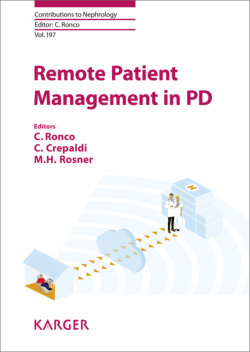Читать книгу Remote Patient Management in Peritoneal Dialysis - Группа авторов - Страница 13
На сайте Литреса книга снята с продажи.
PD Technique Evolution
ОглавлениеGeorg Ganter was the first to study the effects of instilling hypertonic saline in 2 cases with renal failure [1]. Heusser and Wegner attempted peritoneal lavage with 2 catheters (inflow and outflow) for mercury poisoning but despite biochemical improvement, the patients ultimately died [1]. World War II brought with it a tsunami of crush injuries associated acute renal failure with very high mortality rate. In 1946, encouraged by their adaptation of the Wegner continuous flow technique and painstaking attention to sterility, Frank, Seligman and Fine from Boston reported renal recovery and eventual survival of an anuric acute renal failure patient after 4 days of peritoneal lavage. Approximately, 150 cases of acute renal failure were subsequently treated in such manner, although mortality remained very high [3].
Early investigators used 2 catheters in PD: one as an inflow catheter between the diaphragm and liver, and the other for outflow, in the lower peritoneal cavity. The peritoneal lavage was thus continuous in nature. This technique was associated with several complications including leakage of PD solution and infections resulting in high mortality. As a result, this practice was quickly abandoned and the technique using a single catheter for both inflow and outflow (hence the term intermittent) was adopted. It should be noted that the current terminology differentiates continuous and intermittent PD based on the presence or absence of PD solution within the peritoneal cavity for a continuous or intermittent period. For example, intermittent PD has “dry periods during a 24-h time frame during which there is no solution in contact with the peritoneal membrane.
Peritoneal access remained a major challenge in the early days of PD. Different materials and prototypes were tried including Foley catheters, mushroom tip catheters, whistle tip catheters, polyethylene tubes, simple soft rubber tubes with or without side holes, stainless steel sump drains (similar to the metal-perforated suction tubes, used in operating theatres) and even glass drains [11, 12]. Leakage and intraluminal or extraluminal obstruction limited their use, and since the catheter needed to be changed repeatedly over few days, infection risk remained high. It was not until 1950s and 1960s, when investigators like Maxwell, Doolan, Weston and Roberts [3] modified the catheter and improved insertion techniques that the benefit to risk ratio swayed towards PD compared to standard conservative or supportive therapy for acute renal failure. Despite this, the need for repeated intermittent access to abdomen remained a big challenge [12, 13]. The concept of “closed loop circuit” involving storage of PDS in closed containers (as opposed to open containers with open circuits) was introduced by Frank, Seligman and Fine. In this system, the fluid was siphoned out into an airtight container, thus, minimizing the chances of infection. Soon, further modification of this system lead to “hanging bottle system” by Doolan and Maxwell, facilitating the commercial production of PDS [3].
During this time, PD was offered exclusively as in-hospital modality (often offered as a last resort to patients who were not candidates for extracorporeal treatment). A typical “treatment” included instillation of PDS manually by nursing staff several times during the day (requiring multiple changes of entire sets), thus risking contamination and subsequently peritonitis. The first use of PD in ESRD patient was reported in the late 1950s. The patient felt better after just 1 day of treatment. PD was therefore continued on as needed basis with frequent monitoring of plasma chemistry. This patient survived for 6 months after which she decided to discontinue the treatment and passed away [3]. Despite the initial success, long-term PD was frequently associated with recurrent episodes of peritonitis. This, together with the inability to gain permanent access to the abdomen slowed its widespread use. In the 1950s and early 1960s, Normal Deane introduced a prosthesis that was used to keep the catheter track patent in between treatments. This prosthesis represented a significant improvement in the care of these patients, thus obviating the need for recurrent catheter insertion with attendant risk of perforation. Instead the patient would come to the unit twice a week and a stylet catheter was slipped through the permanent track after removal of the Deane’s prosthesis. Oreopoulos et al. [2] used this method in about 40 patients over 2–3 years.
Introduction of the Tenckhoff catheter in 1968 is considered a paradigm shift in the use of PD for ESRD patients. The original Tenckhoff catheter was made from Silastic and represented a technical modification of the curled Palmer catheter. It had an open end and numerous side holes in its terminal part. The 2 Dacron felt cuffs offered protection against infection along the subcutaneous tract: one just outside the peritoneum, and the other in the subcutaneous tissue. The curled section of the Palmer catheter was replaced by a straight intra-abdominal part. Description of various modifications of the original Tenckhoff catheter is beyond the scope of this book but can be found in an excellent review by Twardowski [13].
Another significant contribution towards providing PD as a home-based therapy was the introduction of the cycler machines that could be programmed to provide multiple PD exchanges at home on several days of the week. A detailed description of cyclers will be discussed elsewhere in the book.
